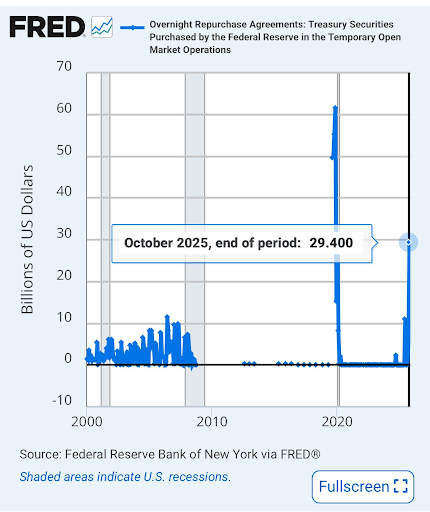- The Fed’s $80B liquidity spike reveals stress in the dollar system, pushing investors toward scarce assets like Bitcoin.
- The U.S. is quietly planning to expand dollar dominance as China strengthens yuan ties with global trade partners.
- Collateral pressure and shifting policies mark a turning point for global finance as America and China vie for currency power.
A fresh liquidity alarm has hit the U.S. financial system, signaling deep stress within the dollar’s core framework. On October 31, the Federal Reserve’s overnight repo facility suddenly spiked to $29.4 billion, marking the highest demand since the 2020 crisis. At the same time, banks secretly tapped the Standing Repo Facility for a record $50.35 billion.
Shanaka Anslem Perera wrote, “This is a $80 billion cry for help in the system’s core.” The Fed has confirmed that Quantitative Tightening will end on December 1, signaling a policy shift. When repo and SRF ignite simultaneously, it usually means collateral stress is pushing liquidity back into the system. Consequently, this situation could ignite strong momentum for scarce assets like Bitcoin while exposing weaknesses in over-leveraged debt markets.
Washington’s Dollar Expansion Strategy Amid China’s Challenge
Besides market turbulence, the U.S. government is quietly mapping a new strategy to strengthen the dollar’s global dominance. Senior Trump administration officials have reportedly held several high-level meetings since August to explore expanding dollar use across foreign economies. These talks involve the Treasury, the White House, and the President’s Council of Economic Advisers, alongside experts like economist Steve Hanke.

According to Hanke, discussions focused on how to persuade more nations to adopt the U.S. dollar as a primary or reserve currency. However, he noted that the conversations remain “deliberative in nature.” Moreover, a White House spokesperson confirmed the meetings, explaining that expert input on key economic issues is routine, though no final policy decision has been made.
China, meanwhile, continues pushing to weaken the dollar’s grip by expanding yuan-based trade and financial links. Beijing recently doubled its 360 billion yuan swap line with South Korea and deepened yuan oil and gas trades with Russia and Gulf nations. Hence, the yuan now accounts for over 5% of global payments, the highest in history.





